Powerdynamo regresa el encendido
y la luz
a su moto clásica
|
|
Powerdynamo regresa el encendido |
|
|||
|
¡Apesadumbrado! |
versión 10.03.2010 |
|
|
Por favor lea primero las instrucciones completamente antes de empezar con la instalación o la modificación de las piezas. Tenga en cuenta las llamadas de atención en la página de informaciones para el sistema. |
| Si no tenga conocimientos técnicos para la instalación, entonces por favor deje realizarla de una persona cualificada o de un taller técnico correspondiente. Una instalación inadecuada causa daño tanto en el nuevo sistema como en la motocicleta. | |
| Antes de pedir el sistema, por favor comprueba mediante la lista de paquetes (o bien la foto
"piezas en volumen de entrega") si la herramienta recomendada de nosotros para
extraer el rotor (extractor) está contenida en el volumen de
entrega. En caso negativo por lo mejor pídala también directamente.
¡En caso de daño al rotor por usar otros herramientas y medios (inadecuados), el derecho de garantía
prescribe! Cuando un rotor está sentado demasiado bajo (por cualquier causa), toca y destruye la unidad de estator que está debajo. |
|
| Si tiene acceso a Internet, vea esta documentación en línea. Puede ampliar los imagenes por cliquear sobre ellos y entonces recibe más
informaciones. Lista del sistema en: http://www.powerdynamo.biz |
|
|
|
El rotor es muy sensible a efectos de golpes (por ejemplo mientras el transporte). |
| Compruebe en cada caso antes de la instalación de la pieza el estado fijo de los magnéticos por intentar apartarlos con los dedos al
lado. Después de efectos de golpes, algunos de los magnéticos pegados podrían haberse soltados y podrían estar fijándose solamente por su poder magnético que resultaría en daños graves en el dispositivo mientras el funcionamiento. Al mismo tiempo, por favor comruebe los magnéticos del rotor por cuerpos extraños (por ejemplo tornillos u otros objetos metállicos). |
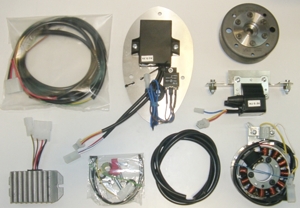 |
Estas partes las debe haber recibido!
Please pay attention: The stator and the sensor are not
screwed tight on the base plate. |

|
To pull the old rotor, you will need a puller tool M10x90 (part 89 99 026). |
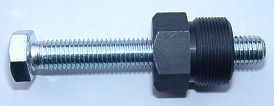 |
Para retirar el nuevo rotor necesita un extractor M27x1.25 (Número de partes 99
99 799 00 -No
en el alcance de la fuente!-).
ATENCIÓN: ¡Al usar un extractor de garras se sueltan los imanes en el rotor! |
|
|
|
|
Notes on wiring: Experience shows that in the course of time nearly every motorcycle undergoes changes to its wiring. As a result, wire colours and wires themselves on your bike might differ to those we describe. In case of doubt, please consult the original wiring diagrams for MZ on the homepage of EastbikesUnited. |
|
|
|
|
| Asegure que su BK se encuentre firmemente en su
soporte, de preferencia en una plataforma de montaje elevada, y que usted tenga un acceso apropiado al lado de la dínamo del
motor. Retire todas las bombillas de 6 voltios de los faros, de la iluminación del tacómetro y la luz
trasera. El viejo claxon puede permanecer.
For driving without battery, please observe our information on driving without battery. You have to decide which method of ignition cut-off you will use. There are different ways, every one with pros and cons. We have pre-assembled the relay option. |
|
|
Relay option (delivered as standard): pro: You may use the ignition lock as previously. There are no changes on the handling of your bike. contra: You can't use the new system without the battery (but in a case of emergency you can drive without, only the ignition cut-off is out of work). |
|
|
Position 5 method:
pro: The bike will be totally driven without battery. This is a big PRO for oldtimer, they will be seldomly driven. contra: You can't cut-off the ignition with the ON/OFF position of the ignition lock, you have to switch the lock short-time on position 5 (previous bump-start position). Further, the bike may be kick-started without ignition key. |
|
|
Cut-off switch method: pro: The bike will be totally driven without battery. There is no relay, that might fail. contra: You have to install an additional cut-off switch, preferably at the handle-bars. |
|
|
|
|
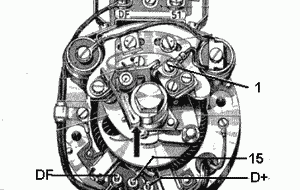 |
Disconnect the cables from your old generator.
That's normally:
Then remove the generator with the regulator and ignition coils. |
|
|
|
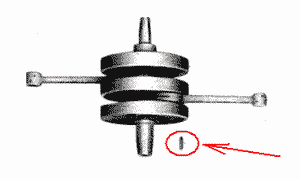 |
Take the woodruff key from
the crank. You will not need it any more. Please do not forget to do so,
otherwise you will have trouble later on the assembly.
(Remark: This woodruff key does not actually hold your rotor on the shaft, this is done by the tapper. It simply guides to the correct setting which will now be otherwise achieved.) |
|
|
|
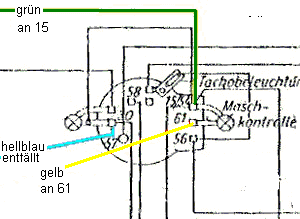 |
Open the lamp casing. Look for the harness with 3 cables, that goes to
the engine. You have to remove the following cables: a) one pale blue-coloured cable on pin 30
(from regulator, pin
51). It will not be replaced by a new wire. |
|
|
|
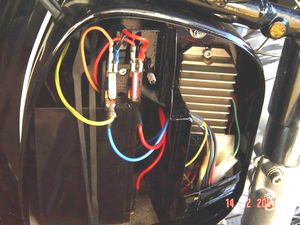
|
Disconnect the battery-plus cable from the fuse box and pull it out of the battery case. Now you have to enlarge the wire entrance hole to 12mm. With the drill at hand, drill a further 12mm hole in the upper section between battery case and tool box. Put in per hole one grommet. Still on the drilling side (but lastly) drill two holes of 5.5-6mm (in the distance of the mounting lugs of the regulator) into the rear wall of the right (tool-) part of the battery case. That will hold the regulator. |
|
|
|
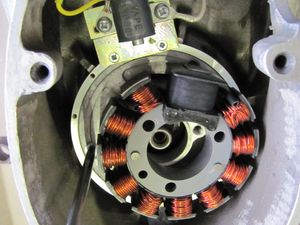
Before you screw down the generator, |
Remove the 3 fixing screws which hold the stator coil to its base. Now you can lift-off the coil a little away from the
ground plate. So as the mounting holes on the ground plate become
accessible. Take care not to damage the paint insulation! Mount the new stator plate (steel- & aluminium ring), using the original mounting holes, on the crank case. The sensor has to shown upwards. Screw it down with the 2 countersunk bolts M5x30. Easiest, first the right one loosely, then the left one. Finally fasten both of them securely. Take care not to jam any wires underneath the plates. This is the most tricky bit of work in the whole installation. So, take it slowly at this point. |
|
|
|
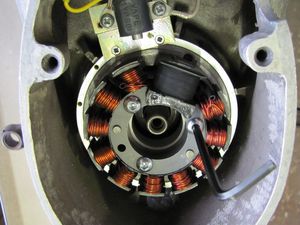 |
Once the plate is fixed, reset the stator coil onto it. Here make
double sure not to pinch any wires underneath. As the coil sits quite low
in the engine, this is difficult to see. Best push the coil gently down and pull at the same time at the wire from rear (ignition coil opening) - little by little until the unit sits properly. At the end, the coil will sort of snap in sharply, even with some noticable click. If it sits down rather softly, that you can bet there is a wire underneath. Screw down the coil with the 3 hex screws M6x30. |
|
|
|
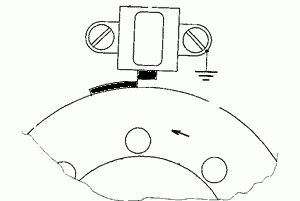
|
Have a look at the new rotor. You will find on its circumference a protrusion. This one is the ignition impulse trigger. Our system reads the time the protrusion needs to pass the sensor and calculates from that how many revs the crank is doing to set the advance correspondingly. That's why ignition always happens after the complete protrusion has passed the sensor. In the picture you see the position of the rotor against the sensor at max advance (25° BTDC). |
| Adjustments at certain ignition angles are often not easy to measure. It's easier to define the top dead centre (TDC). The adjustments of the system were converted and marked on piston position at TDC. You have only to bring any one of the pistons in TDC position, the rest will done by the system (spark advance from ATDC = 3° to BTDC = 25°). | |
|
|
|
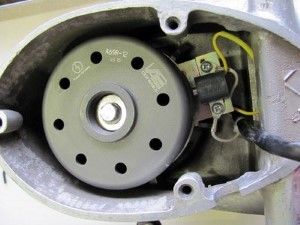 |
Remove the spark plugs to ease turning of the crank. Place the rotor loosely onto the crank and check that it may move freely above the stator base. Bring the piston into TDC position. You may use the new (hand tightened) rotor as a turning knob for that. Insert some gauge, in the simplest case a small screwdriver into the spark plug opening. If you want to shift the crank by the kicklever, use the cylinder at the opposite side to check piston height (with your left hand whilst your right hand presses the kickstarter). At the point where the screwdriver is furthest pushed out, you have top dead center (TDC). Take time to find that point for sure. |
|
|
|
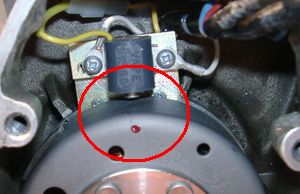 |
Once TDC is found, disengage the rotor carefully without changing the crank's position. Than, reset it onto the crank in such a way that the marking on the rotor (not the protrusion) aligns with the center of the sensor core (a little difference of 1-2mm is acceptable). If there is any bigger change in the crank's position, you have to start again. In that position fasten the rotor carefully with the M7x40 screw (please don't forget to use the washer). |
|
|
|
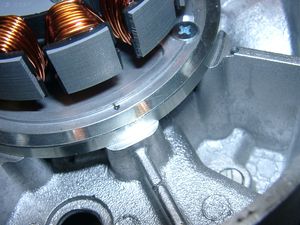 |
Please don't undertake any mechanical changes
on the engine case, thinking that only with some modifications there you
are able to fit the system. It will fit without physical changes, for sure.
The steel adapter of the system will come to sit at the upper recess for the dynamo, as shown here in the picture (and not somewhere further down the engine as you might initially tend to think). (The photo shows another MZ motor.) |
|
|
|
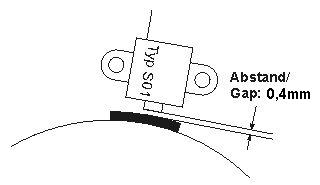 |
Turn the rotor by hand. Check the space between
the sensor and the protrusion on the rotor, it has to be 0.4-0.6mm. You can
adjust that with the locking screws of the sensor. You have to tighten the screws
well after that. It's a good idea to check the screws sometimes. Please equally check that the rotor has no contact with the ground plate. |
|
|
|
|
Time to fit the external parts. Fasten the new regulator vertically
with 2 screws M6 on the inside back wall of the tool box (you have drilled
2 holes there for that).
Now you have to put the new harness. You do that from rear to front of the bike, starting in the tool box compartment. The big white plug remains there and will be connected to the regulator later. Now lead the new harness through the enlarged hole first into the battery compartment. Pull the harness through the partition, until both cables for the battery (red & brown) are through. Then continue to lead the harness through the enlarged hole out of the battery case. The temporarily removed original plus cable (removed temporarily as you have to enlarge the hole) has to be lead again into the battery case and screwed again to the plus pin. In the right (tool box) part of the case you have now the regulator and a "bunch" of cables. Left, in the battery side, you will have the minus (brown) and the plus (red) cable, waiting to be connected over the fuse terminal board to the battery. We have pre-assemled connections for a dryfit (sealed lead/acid) battery, but you can equally fit there round-eye terminals for an ordinary acid battery. |
|
|
|
|
|
Lead the new harness along the frame under the tank and fasten it (not to
fast yet, you may need to re-arrange them a little later on). The harness
will divide at the steering head. Lead the part with the 2
cables (green & yellow) to the lamp housing. Connect them there at the
main switch in place
of the same-coloured placeholders (green to pin 15, yellow to pin 61).
Before you lead the second partial harness to the engine, you have to put a grommet (for the case entrance) over the harness-part and then both black wires in the double plastic plug. Push the contacts in the narrow end of the plug. They have on one side a small hook, for engaging in the plug. If they don't engage, turn round the contacts and try again. No matter which of the black wires is in which position there (it's AC). |
|
|
|
|
| The brown cable with the round-eye terminal from the harness will be lead upwards through the case opening to the ignition coil room. | |
|
|
|
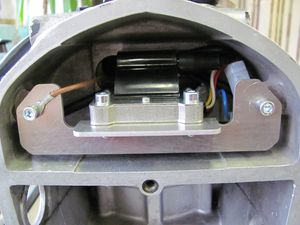 |
Screw both HT-cables onto the ignition coil. Lead the HT wires than from inside the coil compartment through the exit holes outside (just like the original cabled had been). |
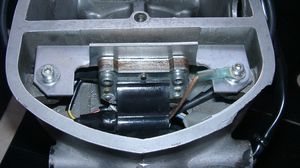 |
Mount the new pre-assembled, electronic ignition coil with screws M5 (please don't forget washers and two nuts as spacers) on the mounting holes of the original ignition coil holder. The even side of the plate shows into direction of the case partition, the coil hangs downwards into the engine case. |
You have to screw down the brown ground cable with the round-eye terminal on the left screw (you look from front to the bike) of the ignition coil holder. At the ignition coil is a shorter blue cable located, let it hang loosely at first. |
|
|
|
|
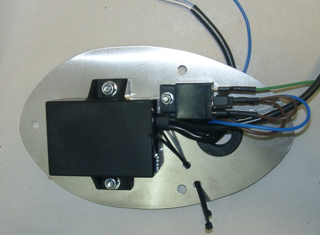 |
Take the oval-shaped plate with the pre-assembled advance unit ("black box")
and the relay. Take a look at the little blue switch block at the upper narrow side of the unit. There are 4 small switches which select the ignition advance curve. Make sure the switches are set as shown below. |
|
|
|

|
Switch 1/2 on ON Switch 3/4 to OFF (that is away from ON). Otherwise your system will not function properly. Please do not experiment with other settings! |
|
|
|
|
Connect the cable, coming from the advance unit and guided through the
hole of the oval-shaped plate to its back, with the plug of the ignition
coil. Pull the short harness from the new generator, the blue wire from
the ignition coil, the green wire from the new harness and the 2 black wire
pairs from rear to front through the opening in the oval plate.
Secure the plate provisionally to the engine (use 2 of the cover screws M6). Connect the 2 plugs with the black wires. Those plugs remain above the baseplate to prevent contact with the rotor. Have a look at the terminals at the relay. 2 of them have a brown wire (ground), one is covered with black insulation. Set the blue wire from the ignition coil to the relay terminal that is closest to the oval base plate. The green wire will be put onto the remaining free terminal at the relay. You will see that wiring as a drawing further down those instructions. |
|
|
|
|
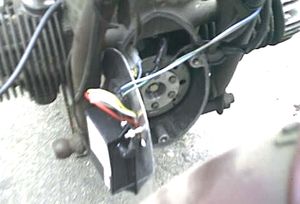
|
Disengage the provisionally set screws, which hold the oval plate. Put on the
generator cover over the whole thing and screw it down - the oval plate
now appearing as some sort of gasket between cover and block.
Take care: pinch no cable! |
|
|
|
| Advice for cut-off by position 5 method (without battery) | |
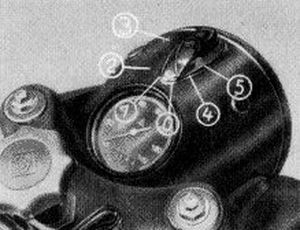 |
To cut-off the ignition, you have to shift into idle gear and switch the
ignition lock briefly into position 5. As soon as the engine has stalled,
turn to OFF and pull out
the key. The ignition lock will be wired in such a way, that in position 5 ground will be connected to the blue cable of the ignition coil, terminating ignition. In position 5 terminal 61 is bridged to terminal 15. From there leads a cable to the neutral gear indicator. Bulb and the idle gear switch with that assembly connect the blue wire of the coil to ground. |
| With position 5 method, the relay on the oval plate will not be used and may be removed. The blue cable of the ignition lock will be connected with the green one from the harness (which leads with the normal battery method to the relay). Without battery the charge control light is not functioning. | |
|
Empalme los cables como indicado en el diagrama de circuito 92xr12 entonces: |
|||||
|
* |
Para hacerlo más fácil el paso del cable por las aberturas estrechas o sea para hacerlo posible, el enchufe del cable que lleva hasta la nueva bobina de encendido desde la nueva dinamo todavía no está puesto en las vías de contacto al final del cable. Usted debería fijar el enchufe sólo cuando el cable está llevado definitivamente por la abertura del motor. Para esto... | ||||
|
|
… tome el enchufe feminino de la unidad anticipada de la ignición con los cables de colores rojo y
blanco.
Ponga el estuche de enchufe 4 aflojado (que está incluido en el paquete) en este enchufe e introduzca los cables aflojados (rojo, amarillo y blanco) de la dinamo con las vías de contacto en el enchufe por atrás. Atienda a que las vías de contacto encajan en la carcasa de enchufe. Con esto hay que atender estrictamente a la posición correcta del cable en el enchufe:
|
||||
|
Si quiere (o tiene que) sacar los cables otra vez de la carcasa de enchufe, lo mejor es de utilizar un sujetapapeles desdoblado y empuje con esto los garfios de las vías de contacto a un lado, para que los enchufes se aflojen. |
|||||
| * |
El segundo enchufe de la unidad anticipada de la ignición hay que conectar con el enchufe de la bobina de encendido. También esto sólo va en una única posición . En esto va ... |
|
|||
| * |
OJO! En ningún caso debería acomodar el / los cable(s) de encendido y el / los cable(s) de la unidad anticipada de la ignición juntos en la misma envoltura o en otra manera por algún tiempo paralelo uno a otro. Esto acaba en una retroalimentación y con esto en averías del encendido, tal vez también en la destrucción de la unidad anticipada de la ignición. |
||||
|
* |
|
El nuevo moderador/rectificador tiene un enchufe compacto con 6 posibilidades de introducir de cuales sólo uno está libre (antes de noviembre de 2007 eran dos). Para el moderador está incluido (a partir de los envíos de noviembre de 2007) en el paquete un equivalente adecuado en cuál hay que introducir los siguientes cables que tienen que encajar allí. | |||
|
* |
Los dos cables negros de la nueva dinamo ... |
... hay que conectar con los bornes 1/4 del nuevo rectificador (desde allí entran entonces también cables negros en el regulador). En esto da igual cuál de los cables va con cuál de los dos bornes (1/4), porque aquí hay corriente alterna. |
|||
| * | El nuevo cable marrón con el ojete de forma de un aro a un lado ... |
... conecta el borne 3 del regulador/rectificador (desde allí también entra un cable marrón en el regulador) con el polo negativo de la batería o bien con masa sólida. ¡Ojo! ¡No debería poner los polos al revés! |
|||
| * |
El nuevo cable rojo con el ojete de forma de un aro a un lado ... |
... conecta el borne 5 del regulador/rectificador (desde allí también entra un cable rojo en el regulador) con el polo positivo de la batería o bien con el borne de la caja de fusible a la cual que llegaba el cable de corriente de la dinamo vieja (motos alemanes: borne 51). |
|||
| Compruebe que haya fusible 16 A entre la batería y la red de bordo. Si haya un fusible viejo, más fuerte (por el dispositivo de 6 Voltio antiguo) al contacto, por favor reemplazelo. | |||||
|
* |
El cable verde/rojo del nuevo regulador al borne 6 ... Indicación: |
... es para la conexión del control de cargar. Aquí hay que conectar (si esté disponible) la lámpara de contról. Claro que esto sólo funciona si está disponible una batería. Si la lámpara de contról está conectada (a pesar de todo) sin batería, la lámpara va a dar luz medio oscura mientras el motor está arrancado, aunque esté producido electricidad. En pocas palabras: Sin batería el contacto se queda libre. También cuando no haya una lámpara. |
|||
|
La navigación de la lámpara de control de cargar es una función adicional
- controlado por transistor - del regulador/rectificador. También si esta
sería defectuosa, la función verdadera de la pieza está garantizada. Esto es muy fácil para comprobar: Deje el motor arranquado, encienda las luces y desconecte la batería. Cuando la luz queda encendida, el regulador está bien. |
|||||
| * |
Queda el cable azúl (de vez en cuando también azúl/blanco) de la bobina de encendido - el cable de apagar. ¡Conectandolo con masa, el encendido se apaga!
Ojo: |
Desconexión por un interruptor adicional: El relé no va a estar instalado. Hay que conectar el cable azúl(/blanco) de la bobina de encendido con un interruptor que conecta contra masa (por ejemplo un pulsador que debería instalar al manillar). Más indicaciones hay en la información sobre la desconexión. Alternativamente puede utilizar un contacto de encendido que apaga contra masa. |
|||
|
Variante de batería: Fije el cable marrón del relé con el ojete sobre la masa. Lleve el cable más largo y negro del relé a un borne del conectador principal que esté en la posición "encendido" y que lleve electricidad (contacto de encendido; en motos alemanes: borne 15 ó 54). Conecta el cable azúl (que viene del borne 30 del relé) con el cable azúl(/blanco) de la bobina de encendido. En caso del fallo de la batería en camino debería desconectar este cable para seguir conduciendo. (¡Pero así el motor no se puede apagar!) |
|||||
|
El cable marrón con el ojete de los bornes 87a y 86 debería conectar con
la masa.
El cable negro del borne 85 llega al contacto de encendido (borne que lleva electricidad en la posición "encendido"). |
||||
| * |
El cable de alta tensión (cable de encendido)...
Por favor, no utiliza el "Nology Superkabel"/"Nology Supercable" ("hot wire"). Ellos producen averías con sistemas de Powerdynamo y pueden producir daño de la electrónica. |
… lo atornille en la bobina de encendido y pone la tapa de goma sobre ello. Claro que esto va mucho mejor si lo haga antes de instalar la bobina en el vehículo. Por favor sólo utilize el cable de encendido incluido en el paquete y no uno viejo, indefinido. | |||
|
Hagase un favor e invite a vuestra moto a tener unas nuevas bujías y unos enchufes de bujía (de preferencia con
resistencia de 0 a 2 kOhmio). ¡Muchas averías se deben a "pareciendo
buenos" cables, bujías o enchufes (entre ellos absolutamente nuevos)!
No utiliza bujías con una resistencia de desaveriar al interior. Por ejemplo NGK ofrece unas bujías con el códico "R" ("R" por resistor). |
|||||
| * |
|
En nuestras bobinas de encendido dobles llegan ambas salidas primero a las bujías
y sólo por ellos a la masa.
La resistencia típica entre las dos salidas totaliza 6,2kOhmio. Ambos canales siempre calientan al mismo momento (que es - por cierto - el caso normal en muchos sistemas de encendido y que es sin escrúpulos). Pero las chispas tienen a ambos lados una fase desplazada por 180 grados cada uno, que debería tener en cuenta en mediciones con el estroboscopio. |
|||
| El encendido sólo funciona correctamente si ambas bujías están conectadas con la bobina. Entonces no puede quitar una sólo para comprobar. Porque cada salida coje masa por la bujía de la otra salida. Si quiere comprobar verdaderamente sólo un lado, debería poner la otra salida de la bobina sobre masa. Luego la conexión funciona como la de una bobina con sólo una salida (mire más arriba). Si el curso de electricidad de un lado está interrumpido, o no funciona nada o el sistema coje masa del punto más cercano. Muchas veces esto tiene de consecuencia unos fuegos artificiales alrededor de la bobina de encendido. Los que necesitan verdaderamente dos salidas separadas tienen que utilizar 2 bobinas solteras. | |||||
|
* |
Para terminar - antes del primer arranque - por favor compruebe con toda calma todas las fijaciones y todos los cableados. No olvida de cambiar todas bombillas de 6 voltio por las de 12 voltio. El claxon de 6 voltio puede quedarse. Si el sistema no funciona directamente, por favor consulte nuestra página de busqueda de errores. Para primer paso separe el cable azúl entre el relé y la bobina de encendido (extraer el contacto). En el sector de apagar se esconde la mayoridad de los errores. |
||||
| * |
IMPORTANTE: Por favor, tenga en cuenta que el tapón de dinamo del cigüeñal se ha hecho más corto por embalarlo en una regeneración del cigüeñal casual (anterior). Por eso el rotor está más abajo y se puede producir un contacto entre el rotor (los remaches son el punto más abajo) y la bobina de estator. El resultado es un estator destruido y por eso una interrupción de
encendido. ¡Para más informaciones mire (en línea) aquí! |
||||
|
Importantes llamadas de atención de seguridad y de funcionamiento: |
|
|
# |
Haga caso a las llamadas de atención de seguridad e imposiciones reglamentarias del fabricante del vehículo y del oficio de vehículos. |
|
# |
¡Centrales de cebado producen alta tensión! ¡Con nuestras bobinas de ignición hasta 40.000 voltio! ¡Esto no sólo puede hacer mucho daño si lo utiliza siendo incauto, sino también puede causar problemas para el corazón! Por eso preserve siempre la distancia de seguridad al electrodo y a cables de alta tensión abiertos y en el test siempre pulse con fuerza el macho de enchufe de la bujía de encendido (enchufes de bujía) con un objeto aislador a la masa para desviar seguramente el voltaje. |
|
# |
Después de la instalación, por favor compruebe el estado fijo de los tornillos de apoyo del estator y (si existente) del senor. Si las piezas se aflojan, se surgirá la destrucción. ¡Sólo apretamos los tornillos en el preénsamblaje sueltamente! |
|
# |
Dele primero por lo menos una oportunidad al dispositivo recién instalado de encenderse, antes de empezar de medir y de comprobar todo si funciona verdaderamente. O peor: hacer modificaciones directamente sin haber encendido la instalación. Todas nuestras piezas están comprobados antes de la entrega. Además no van a tener suerte medirlas. Por favor, deje la medida de las piezas electrónicas (entre ellas la bobina de encendido con excepción de su salida de alta tensión). ¡Ariesga la destrucción y no van a llegar a resultados usables! Piense en esto: también pueden ser el carburador y sobre todo los soportes de bujía y las bujías (por lástima también las completamente nuevas) si el motor no va directamente (regularmente, después de la instalación de Lima, también sus regulaciones deberían ser cambiadas). Si el dispositivo no va directamente, sobre todo compruebe las conexiones de masa, pone por lo menos para el test un nuevo cable de toma de tierra de nuestro regulador directamente al motor. |
|
# |
Si tiene un dispositivo con bobina de encendido doble, por favor tenga en cuenta algunas particularidades de esta bobina. El encendido sólo funciona corectamente si ambas bujías están conectadas con la bobina. Entonces no puede quitar una bujía sólo para testar. Es porque cada salida carga masa por la bujía de la otra salida. Si quiere testar seguramente sólo un lado hay que poner la otra salida de bobina sobre masa. |
|
# |
La chispa de centrales de interrupción clásicas tiene con 10.000 voltios sólo una energía pequeña y es por eso amarilla y gorda. La chispa de nuestras centrales es una chispa de alta energía con hasta 40.000 voltios y es por eso muy concentrado y azúl, que le hace menos buen visto. Además esta chispa está producida sólo con un número de revoluciones pedaleado con el pedal de arranque. Sólo estirar el pedal de arranque con la mano no produce una chispa. |
|
# |
Nunca hacer la soldadura de arco eléctrico en la bicicleta sin desconectar completamente todas las partes que contengan semiconductores (bobina de encendido, regulador de antelación) estator y el rotor no es necesario que se deban tomar fuera. |
|
# |
La electrónica es sensible al polo falso. Compruebe siempre después de una intervención al sistema la conexión correcta de la batería y el cableado correcto. Polos falsos y cortocircuitos destruyen el regulador y la bobina de encendido. Normalmente hay que conectar en el cableado siempre color con color. Excepciones están mencionadas explícito en la instrucción. |
|
# |
Atienda a no romper los imanes mientras la instalación del rotor. Evite la influencia mecánica y directa al rotor. Para el transporte de la Lima nunca ponga el estator en el rotor, atienda a las indicaciones para el envío (embalaje). |
|
# |
No utilice enchufes de bujía con una resistencia a más de 5 kOhmios. Recuerde que enchufes de bujía envejiecen y que intensifican con eso su resistencia. Si un motor sólo arranca en estado frío con gran seguridad la razón es un enchufe de bujía defecto. No utilice cables llamados aumentando el encendido (por ejemplo Nology). |
|
# |
Engrase el rotor un poco por fuera, sino va a corroerse rápidamente en el entorno agresivo (que no hace daño pero parece muy feo). |
|
# |
No utilice nunca un para extraer el rotor un extraido de forma de garras o un martillo. Con estos se podrían aflojar los imanes. Siempre sólo un extraido de tornillo solo M27x1.25 (mire las instrucciones de instalación). |
|
# |
Si vuestro vehículo no está utilizado por un poco más tiempo, debería desconectar la batería (si existente) para evitar una descarga lenta por los diodos del rectificador de corriente. Pero también va a darse cuenta de una descarga de la batería después de algún tiempo aunque habrála desconectado, eso es normal. |
|
# |
Por favor presta atención a estas indicaciones pero tampoco dejese confundir. Antes de usted, miles de clientes ya han instalado nuestros dispositivos con éxito. ¡Mucho éxito y que se divierte conduciendo! |